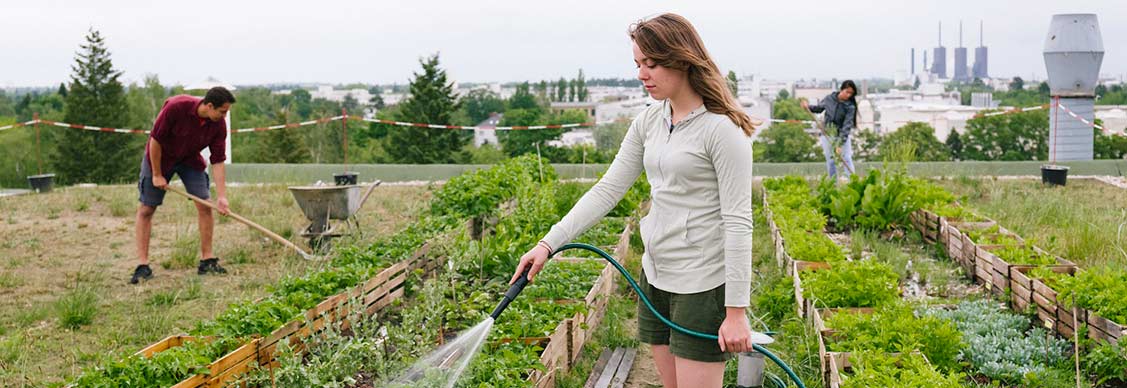Why green rooftops are sprouting around the world
Roofs are increasingly becoming green spaces as part of a drive towards cleaner cities
Whether it’s carefully cultivated gardens or urban farms, a growing number of green roofs are growing atop buildings across the world’s cities.
The market for green rooftops is set to grow by US$8.8 billion by 2025, according to a report from Technavio, a market research firm. It found that Germany, the U.S., Japan, Canada, and Singapore are the largest markets for green roofs.
Amid a broader push from companies and governments driving toward net zero goals, for which the built environment can play a critical role, the rising number of green roofs stems in part from new financial incentives and regulations.
Toronto, for example, introduced laws for new buildings or extensions greater than 21,000 square feet back in 2009. Since then, developers have had to cover between 20 percent and 60 percent of their buildings with vegetation – and while they can opt out for a fee, fewer than 10 percent choose to do so, according to data from Toronto’s City Hall.
Other cities have opted for more flexibility. In San Francisco, 15 percent to 30 percent of roof space on new buildings must incorporate solar panels, green roofs or both.
“Local government policy has and continues to be the major gamechanger as more cities aim to improve air quality, protect against flooding and heat stress during heatwaves, and build nature back into the urban environment,” says Isabel Scruby, Planning, Development & Heritage consultant at JLL.
It’s a far cry from when green roofs first appeared 50 years ago. Back then it was often charities or housing cooperatives leading the charge in German cities such as Düsseldorf and Stuttgart, today considered Europe’s green roof capital.
Driving a greener future
Today, there are often financial incentives for going green. In Hamburg, green roofing measures are subsidised with a grant up to €100,000 (US$116,500).
In the U.S., Philadelphia’s tax credit scheme and Washington DC’s stormwater regulations both encourage green roofs.
“The challenge is for those areas where there are low levels of greenery to improve, says Andrew Baker, UK Head of Sustainability Consulting. “That will require more developers and existing real estate owners to embrace to the idea.”
More increasingly are. In London, for example, rooftop gardens are becoming a feature of high-end residential developments including Islington Square and the redevelopment of Battersea Power Station.
In New York, the Brooklyn Navy Yard is covering 23,000 square feet of industrial rooftops in vegetation to help reduce stormwater.
While there are certainly practical issues to overcome, from transporting materials onto the roofs to ongoing irrigation and stormwater management, there are also benefits for investors and tenants.
“Developers or redevelopers sometimes need convincing of the benefits of a green roof on a property’s long-term value and energy efficiency,” says Baker.
While utility costs vary between cities, the National Research Council of Canada estimates a green roof can reduce air-conditioning use by up to 75 percent.
Looking for more insights? Never miss an update.
The latest news, insights and opportunities from global commercial real estate markets straight to your inbox.
Appealing to modern tenants
While green rooftop space can be left vacant or landscaped for recreational use to help improve health and wellbeing among building tenants, some rooftops are going down a different route.
With greater public concern over climate change and a growing appetite for locally sourced produce, urban farming is taking off, with fresh vegetables grown at elevated urban farms like Agripolis' Nature Urbaine in Paris.
In the UK, the Crown Estate’s Princesshay rooftop garden is home to over 300,000 bees. Since launching in 2012, honey is sold in the shopping center below.
“Using green roofs to grow fruit and vegetables is a great opportunity to move rooftops away from purely recreational use and drive more value from them while also benefiting the local community and wildlife,” Baker says.
While the number of green rooftops – and their range of uses – continues to grow, there’s room for the concept to grow further as cities such as Paris and London look to a greener future.
“As planning policy filters through and has a greater impact on developer thinking, there’s a strong possibility adding a green roof simply becomes part of planning applications,” Scruby says. “That’s the hope. We’re not there yet - but progress has been made.”
